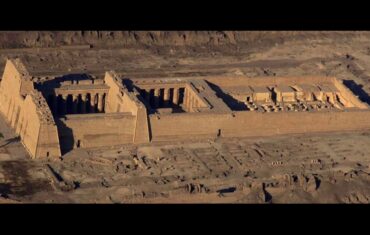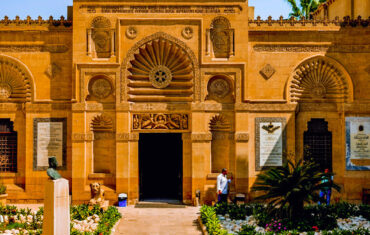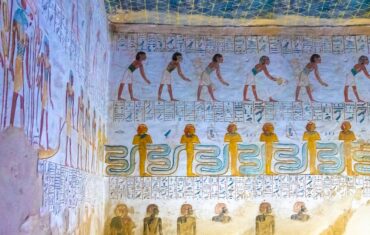The funerary temple of Queen Hatshepsut is known as “Djeser-Djeseru” which means “The wonder of wonders.” It is one of the most beautiful temples that you can find in this place full of beautiful tombs and temples, it is located next to the Temple of Mentuhotep II (of which only vestiges remained) and a few kilometers from the Valley of the Kings and the Valley of the Queens in Luxor.
HATSHEPSUT, THE THIRD QUEEN-PHARAOH IN EGYPTIAN HISTORY

Queen Hatshepsut went down in history for many reasons, one of the most striking is that it became pharaoh against all the laws and customs of that time, which made her one of the few women who reached that range, the third queen-pharaoh of history of Egypt.
Hatshepsut, which means “The first of the noble ladies” or “the main lady of the nobility” or “The first of the noble ladies, united to Amun.” Daughter of Tuthmosis I and the queen -main wife- Ahmose Nefertari. Hatshepsut was soon widowed from the marriage with her stepbrother Tuthmosis II, who had made her queen consort. At this time, she decides to take over the government until her stepson (Tuthmosis II had a son with one of his secondary wives) Tuthmosis III reaches the necessary age to govern but, in reality, he will never leave the office.
After seven years of regency, Hatshepsut changes her name to Maatkare Hatshepsut, which would be her throne name, which postulates her as the sole sovereign of Egypt. At the same time, he begins to adopt the typical attributes of the pharaoh, such as the false beard that this title represents (in the Cairo museum you can see a bust of it), the statues that represent her have a male body with its corresponding outfit, which was a declaration of power that led to the self-proclamation of the pharaoh of the Two Lands – King of Upper and Lower Egypt and the first-born of Amun.
 This fact caused Hatshepsut and Tuthmosis III to rule as pharaohs at the same time but, despite what can be read today, many Egyptologists consider that the queen pharaoh was well received by the population because there were no major conflicts, nor civil wars and that Hatshepsut’s rule was one of the most prosperous reigns. Of course, for this to be carried out under these conditions, the support that this queen had was necessary and essential, both from the high priest Hapuseneb and from the architect Senenmut.
This fact caused Hatshepsut and Tuthmosis III to rule as pharaohs at the same time but, despite what can be read today, many Egyptologists consider that the queen pharaoh was well received by the population because there were no major conflicts, nor civil wars and that Hatshepsut’s rule was one of the most prosperous reigns. Of course, for this to be carried out under these conditions, the support that this queen had was necessary and essential, both from the high priest Hapuseneb and from the architect Senenmut.
After years of reign, when the construction of the Deir el-Bahari temple (the funerary temple that we show you in this article) ends, the weights of power begin to change between Tuthmosis III and the pharaoh queen. He wanted power, it is said that at any cost, and in a short time the two great supporters of the queen, Hapuseneb and Senenmut, died. In turn, a little later, Princess Neferura died (the causes are unknown), whom Hatshepsut had designated as her heir to the throne since it could be that the queen-pharaoh wanted to create a female dynasty of kings. All this caused Hatshepsut to partially retire from office and stay in her palace in Thebes.
But the story does not end here, not even after her death, because for many years the figure of Hatshepsut was erased from history, eliminating any reference to her reign, destroying the temple reliefs in which she appeared and even her name was not in the List of Kings. Tuthmosis III has been pointed out on many occasions as the cause of this, due to the rivalry that existed between them, but more recent investigations believe that it was also done gradually in the following dynasties.
FUNERARY TEMPLE OF QUEEN HATSHEPSUT
As we mentioned earlier, the funerary temple of Queen Pharaoh Hatshepsut was considered one of the most beautiful temples, the wonder of wonders. Egyptologists describe how this place had a large palm grove and a beautiful grove, where trees brought from Hatshepsut’s travels and exchanges could be found, such as the henna tree or the incense tree; in turn, in the center of it was a large pool that created a paradisiacal image.
Today, as you can see in the photos, that image does not correspond at all to the present day and we are in a desert place and without the possibility of resting under a shade until we reach the interior of the temple (aspect to take into account for your visits ).
The archaeologists found the temple in poor condition, which means that we are facing a temple that has required major renovations. On the one hand, it is said that this temple was covered with sand almost up to half, which meant that many parts of the temple deteriorated but, at the same time, the actions carried out by Tutmosis III, to whom they attribute a great number of destruction: decapitation of her statues, erasing her cartridge (her name), disfiguring the images and reliefs where she appeared. The reason? Three possibilities are considered: revenge, guaranteeing the succession of his son to the throne or eliminating a woman who would have intervened in the succession of male kings: Tutmosis I, II, and, finally, Tutmosis III.
On the second floor of the temple, there are reliefs that show the expedition made by the pharaoh queen to Punt, a country on the shores of the Red Sea, from where she brought trees and other exotic products. In turn, in the reliefs you can also see her biography, how she came to be the pharaoh queen since she chose what themes of her life she wanted to perpetuate in the temple or the gods to whom she wanted to dedicate the space.
The second and third floors of the temple are carved out of the rock and on the other side is the Valley of the Kings. It is said that there was some communication between the temple and the tomb of the Valley of the Kings, in this way the offerings and rituals that were made in the temple would serve to nurture the spirit of the queen.
 This temple is dedicated to the god Amun Ra (king of the gods, king of the sun) and herself, as did all the pharaohs. Inside there are also chapels in which smaller gods were worshiped, such as Anubis (god of death) and Hathor (goddess of fertility). You can easily recognize them since Anubis was represented with a jackal’s head and Hathor was represented in the form of a cow.
This temple is dedicated to the god Amun Ra (king of the gods, king of the sun) and herself, as did all the pharaohs. Inside there are also chapels in which smaller gods were worshiped, such as Anubis (god of death) and Hathor (goddess of fertility). You can easily recognize them since Anubis was represented with a jackal’s head and Hathor was represented in the form of a cow.
In the chapel dedicated to Anubis, you will clearly see how the god is kept in good condition, with some polychrome engravings, while the relief of the figure that gives the offerings to the god is disfigured. That is where the pharaoh queen was represented and, through this disfigurement, she was erased from Egyptian history.




